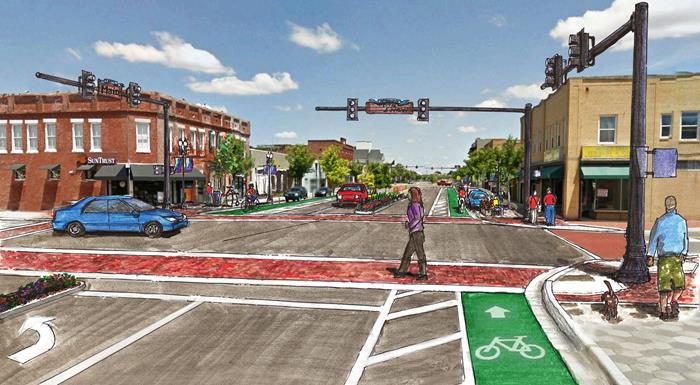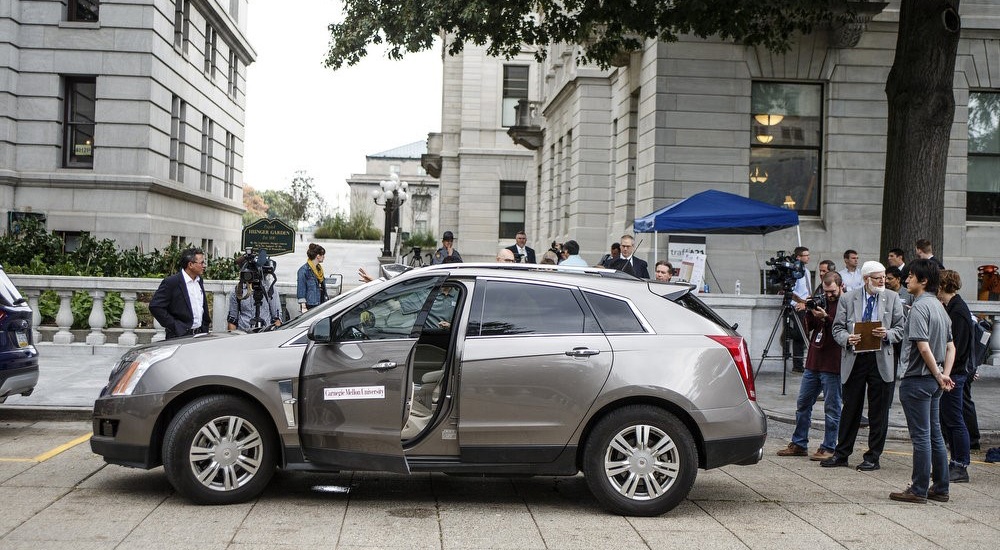The importance of greater mobility choices in the community and five things communities need to do to launch their own transformations
By Fred Jones, AICP │ Senior Project Manager │ Michael Baker International
From the Fall 2017 issue of Signature
Context-Sensitive Solutions, Livable Streets, Green Streets, Right-Sizing, Home Zones, Walkable Communities, Complete Streets – whatever you want to call it, we are in the middle of a paradigm shift in the way communities are thinking about roads and roadway design.
Driven in part by a groundswell of communities across the country looking to substantially improve quality of life, the Complete Streets movement recognizes the need for a better, more comprehensive way to design our transportation infrastructure. This movement stresses the importance of improved safety, health, economic and environmental outcomes as intrinsic components of the entire project lifecycle.
In short, Complete Streets represents both a policy and design framework aimed at designing roads with all users in mind, not just motorists. Beyond aesthetics and attractive landscaping, this approach emphasizes greater mobility choice, balancing the interests of pedestrians, cyclists, motorists and transit users of all ages and abilities with an “outside-in” philosophy governed first and foremost by placemaking and urban design.
However, no one-size-fits-all, singular solution exists for the perfect Complete Street. A Complete Street may include sidewalks, bike lanes, dedicated transit lanes, comfortable and accessible public transportation stops, safe crossing opportunities, median islands, accessible pedestrian signals, curb extensions, narrower travel lanes, roundabouts and more. The Complete Streets approach isn’t about adding ribbons and bows until the package looks good – it’s about rebalancing the roadway space in the right location at the right time.
WHY THE SHIFT?
For the better part of the past 70 years, communities have done a tremendous job designing their roadways to accommodate the efficient mobility of the car. In combination with a segregated-land-use regulations and housing finance policies, this has led to a state of automotive dependency in many areas of the country, making it largely impractical – and dangerous – for non-motorists to walk, bike or use mass transit.
From public health and safety standpoints, the increasing levels of inactivity and the growing numbers of injuries and fatalities to walkers and cyclists across the nation can be attributed to the lack of walkable, human-scaled design in our communities. This movement away from largely “incomplete” streets to facilities that are designed to make travel choices more safe, accessible, convenient and attractive isn’t merely a fad.
Redesigning our roads to support greater transit use and multimodal trip-making improves the capacity and efficient movement of travel within the same amount of curb-to-curb roadway space, reducing single-occupancy auto congestion while improving cardiovascular health via walking and biking opportunities.
In addition to the obvious health, safety and mobility benefits, one of the primary reasons for the shift is the increasingly recognizable economic value of “walkability.” Complete Streets can fundamentally improve walkability. Walkable neighborhoods have demonstrably higher home values that their drivable, suburban counterparts.
Based on recent data from WalkScore and the “CEOs for Cities” report, in most metro areas, for each additional point on the 100-point WalkScore scale, home values generally increase from $500 to $3,000 in value. In Washington, D.C., for example, walkable commercial cores yield 75 percent higher office rents typically than their suburban counterparts. Millennials and Baby Boomers have played a huge role in driving this demand as well.
GETTING STARTED
Communities will find many effective ways to introduce a Complete Streets framework. For those that are just beginning to have the conversation, remember, this truly is about a paradigm shift and not merely about installing a new bike lane or sidewalk as a project amenity. Here’s how to get started:
- BUILD CHAMPIONS – It’s important to communicate the benefits of the Complete Streets plan clearly and build champions early in the process to keep the message and implementation on target. Leverage proposed resurfacing opportunities to get quick wins and build momentum.
- EDUCATE AND ENGAGE – This also means sticking to a personalized message or storytelling approach that resonates with the community and stakeholders to get collective buy-in. In Jacksonville, Florida, for example, the key message was for the city to get off the “Dangerous by Design” list of the top metro areas with the worst pedestrian danger index. The solution? A Complete Streets approach to transportation design. Communities should make sure they drive their Complete Streets visions with hard data and benefits that are tangible and measurable over time – whether safety (i.e., reduced severity of accidents), economic (i.e., increased real estate investment) or environmental sustainability-related (i.e., reduced emissions and runoff).
- START WITH DEMONSTRATION PROJECTS – The key approach here is to avoid swallowing the elephant. This low-cost “pilot” strategy tests Complete Streets concepts and gathers community feedback. Using temporary installations such as parklets or planting bollards that may only stay in place for a few weeks, communities can test new ideas and designs, allowing residents to experience new concepts or design ideas that may be unfamiliar to them while proving that “the traffic didn’t get worse.” This strategy greatly reduces resistance to testing innovative solutions and provides insight on desirability and feasibility. Often these pilot projects become permanent.
- CREATE ENGAGING COLLATERAL – Attractive, easy-to-read materials are the best way to get the attention of key stakeholders, particularly elected officials. Sometimes it’s all about telling the right story. Using creative multimedia strategies tailored for each specific project (including the production of attractive summary materials, videos, presentations, and interactive Web sites) that hit the emotional core of stakeholders can mean the difference between success and failure. Outreach efforts should be broad, especially targeting special-interest group needs.
- USE CONTEXT TO DRIVE THE PROCESS – Communities should begin the conversation by defining the right content characteristics, particularly when seeking buy-in from departments of transportation. Based on the New Urbanist Transect system, the use of a context-based classification approach facilitates up-front agreement on important project elements such as speed, lane widths, potential lane elimination and other Complete Street design outcomes. Corridor planning and design flexibility should be driven by the existing or desired future form and context of the transportation facility through its physical characteristics, not highway-functional classification.
DESIGNED FOR COMMUNITY OR CAPACITY?
As community leaders continue to revitalize their communities, they should keep in mind that the Complete Streets approach really is about creating a “network of opportunity,” through a variety of choices, that is both responsive to community context and serves to enhance its sense of place. Creating a network of opportunity is about increasing multimodal accessibility to jobs, neighborhoods, shopping, and leisure for everyone, ultimately transforming communities into ones that are lasting, livable and economically competitive.
Any time communities introduce a paradigm shift, they will face resistance. Often, Complete Street efforts face opposition from both professionals in the traffic engineering community and the public. Most of this resistance, though, stems from the perception that any new design will result in a loss of road capacity and vehicle throughput and consequently will lead to greater traffic congestion.
An open and honest assessment of tradeoffs early in the process generally will result in greater acceptance in the long run, or at least informed consent, especially when the conversation about a community’s street is reframed as a place designed for community versus road capacity. If communities begin with the simple question of whether they want their street to serve as an area to “come through” versus one “come to,” most ultimately will prefer the latter.



